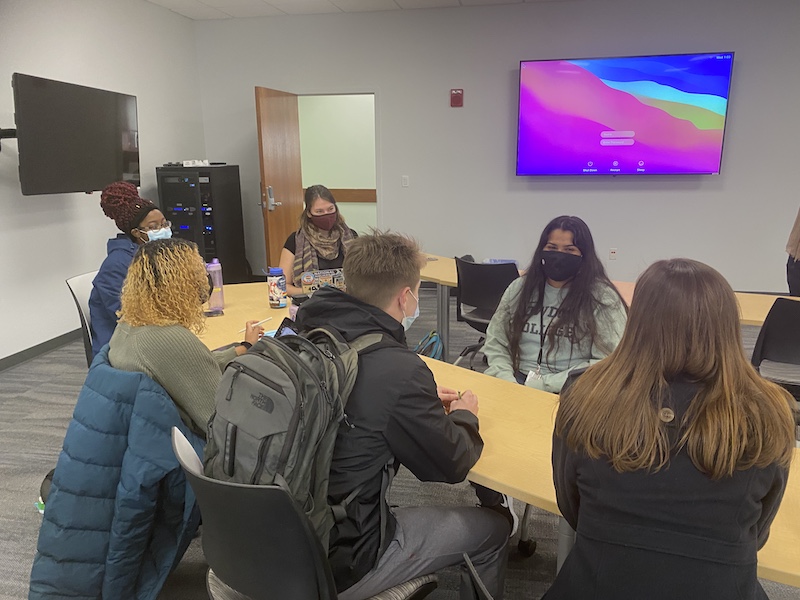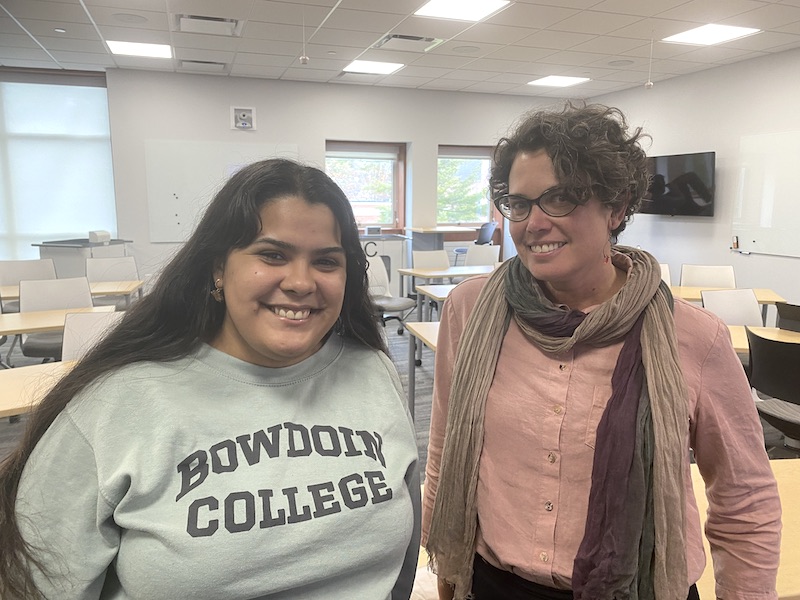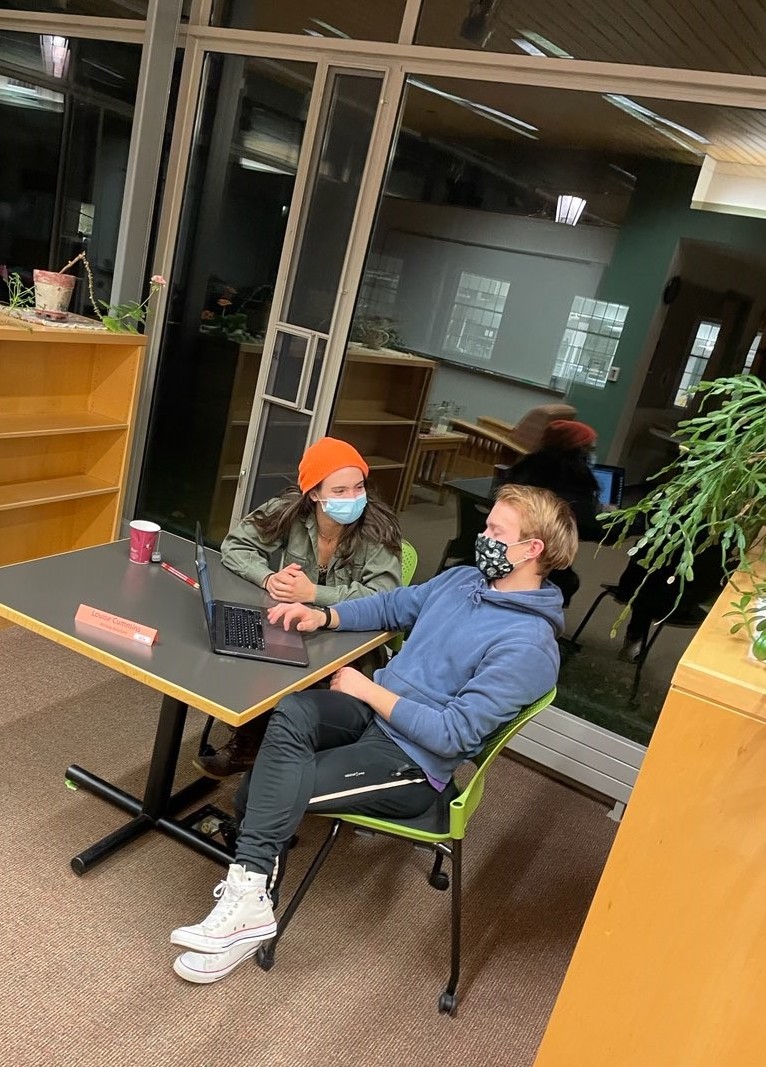Students Join Professors in Classrooms as Learning Assistants
By Rebecca Goldfine
Almost two hundred Bowdoin students are working with classes across the curriculum—in the humanities, social sciences, and sciences. While most are in STEM classes, many others are assisting classes in anthropology, cinema studies, English, and other departments that have not traditionally had teaching assistants.
Last year, when almost all classes went online, the BCLT hired students to aid with technology, fostering connections among students scattered around the world, and enhancing the quality of learning environments for students. Faculty reported back positively on the program, and the center recommitted to it this year.
Katie Byrnes, director of the BCLT, said the assistants focus on helping their peers study and learn more effectively.
"In the past we have had teaching assistants and study group leaders, but we have merged them into one learning assistant model to build a consistent program across campus departments," Byrnes said. "All learning assistants engage in some foundational preparation with us about the science of learning, of pedagogy, so we have a more standard preparation for students working with their peers."

Before the start of the semester, all the learning assistants complete online modules and an in-person session, including one on anti-racism. "We offer four hours of professional development," Byrnes said, "but they also get job-specific training through the department."
Academic departments and programs decide which of their courses would benefit from learning assistants, and faculty select specific students to work with, mostly upperclass students majoring in their field. The BCLT hires and compensates them.
Byrnes herself worked with two learning assistants for Educational Psychology, a 2000-level education course she taught last spring. Both assistants supported students with projects and facilitated small-group discussions in class, among other tasks.
"They were two students who had taken the course the year before, so they knew the class," Byrnes said. Meeting weekly, they gave her feedback about her assignments and lesson designs, and kept her up to date on what was going on with students.
Byrnes said some professors are surprised to find that learning assistants can offer more than just technical help. "A lot of professors are realizing that their course is better because they're having an ongoing conversation with the learning assistant about the class," she said.
Doris Santoro, professor of education, agreed. Her learning assistant, Esther Fernandez Rosario ’23, offers her "a temperature of the class and what is happening on campus, so I am able to better judge the effectiveness of my teaching," she said.
Santoro has had teaching assistants in the past, but this fall is the first time she's working with a BCLT-trained learning assistant for her Contemporary American Education course. She's pleased that the BCLT has formalized the learning-assistant model. "The College is demonstrating that there is a value to peer teaching and peer support," she said.
Rosario meets one-on-one with students throughout the week and attends the twice-weekly class. She also aids Santoro in assessing homework or exam questions and grading rubrics. (For the midterm, Rosario put together a tip sheet, much to the relief of the students. "It provided this sense of 'I’ve been there, done that, and here is how you can succeed in this task.' That was huge for students," Santoro said.)
But Rosario ends up providing more than just class-related mentoring. "I have definitely seen that some students in my class gravitate to Esther not only for support in the class, but support in navigating Bowdoin and meeting academic expectations writ large," Santoro said. "While I certainly can offer guidance and insight, someone who has gone through that two years ago is much more convincing."
An education and English major and a Hispanic studies minor, Rosario aspires to be a teacher or school administrator herself, and is planning to enroll in the Bowdoin Teacher Scholars program. "I really love contemporary American education and the content we learned about, so to get paid to talk to other people about it seemed super great to me," she said, explaining what drew her to the job.
And while she's supporting other students' success in the course, she says she's gaining a lot in return. "It helps me be an effective communicator and a more effective learner and student myself," she said. "I can’t help others unless I’ve taken care of my needs first. If I'm going to help people with time management, I have to get my time management skills in order too!"
Vyjayanthi Selinger, Bowdoin's Stanley F. Druckenmiller Associate Professor of Asian Studies, is working with one learning assistant, Nana Hayami ’22, for her Intermediate Japanese class this fall. All the other Japanese and Chinese classes also have learning assistants. Hayami and Selinger alternate to provide each student weekly one-on-one conversational lessons, doubling the practice time they have with a fluent speaker.
Selinger has also observed that learning assistants in the Japanese department, like Rosario in education, benefit academically and personally from the experience. "Japanese is sometimes a language they speak at home," she said, but because they often have never studied it formally, they're pleased to learn the underlying grammatical logic.
"And they experience a pride and joy when they see someone else put so much effort into their language," she added. "I think it travels in both directions among students, that feeling of appreciation. The learning assistants say, 'Thank you for learning my culture!' and the students say, 'Thank you for teaching me your culture!'"


